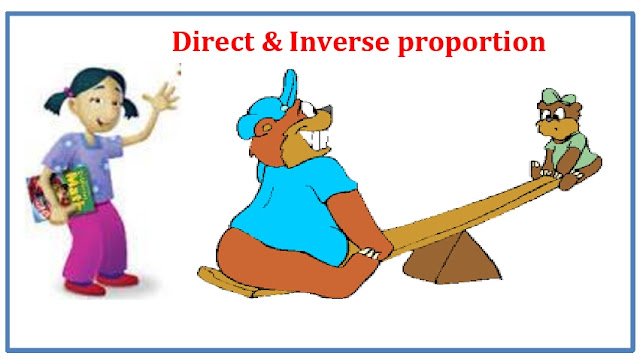Lesson Plan of Direct and Inverse Proportion Involving in Real Life Problems Mathematics Grade V
Lesson Plan of Direct and Inverse Proportion Involving in Real Life Problems
Mathematics Grade V
Students’ Learning Outcomes
·
Solve real life problems involving direct and
inverse proportion (by unitary method)
Information for Teacher
·
In unitary method we deal with the following:
·
Finding the price of more things when price of
one thing is given
·
Finding the price of 1 thing if price of more
things is given
·
Finding the price of given number of things if
the price of other number of same things is given
·
Ratio: A
ration shows the relative sizes of two or more values
Ration
means a relation between part to part or part to whole
·
Proportion: when two rations are equal they are said to
be in proportion
·
During lesson where and when necessary consult
textbook
Resources / Material
Board,
chalk/marker, chart paper, packets or tins of food items, textbook
Worm up activity
·
Show students a packet of juice and read the
information for ingredients
·
The label on a juice pack shows this information
·
Apple juice 440ml, each 440ml provides:
o Energy
226 calories,
o Carbohydrate
6.6g,
o Vitamin
c20mg
·
Ask the students that if 440 ml of juice
provides 226 calories how many calories 100ml of juice will provide?
·
Ask students to decide is it direct or inverse
proportion question, can they show the working? If they are unable, show
working on the board
Solution:
440 ml of juice contains calories =226
I ml of juice contains calories = 226 /440
100 ml contain = 226 / 440
x 100 = 56.5 Cal
·
Ask again is it direct or inverse proportion and
why?
Development
Activity 1
Discuss the following questions with the whole class:
·
What is ration?
o A
ration shows the relative sizes of two or more values
o Ration
means a relation between part to part or part to whole
·
What is proportion?
o When
two rations are equal they are said to be in proportion
·
If increased in one quantity causes decrease in
other quantity or decrease in one quantity, then we say that both quantities
are inversely related
·
Two values are in “direct proportion” with each
other if the following relationship holds: whenever one variable doubles, the
other variable doubles
·
Whenever one variable triples, the other
variable triples and so on
·
Ask the students “Do you remember the proportion
tables we did in the previous lesson?
·
Show them following tables and recollect the
information about direct and inverse proportion
Table 1
|
Table 2
|
|||
Number of men
|
Weight
(in pounds)
|
No. of workers
|
Days to complete
work
|
|
0
|
0
|
5
|
16
|
|
1
|
165
|
8
|
10
|
|
2
|
330
|
10
|
8
|
|
3
|
475
|
20
|
4
|
|
4
|
655
|
30
|
2
|
|
·
Solve table on the board with the help of the
students
·
If 5 workers complete a job in 16 days, then 8
workers will complete the same job in how many days?
5 worker complete the job in = 16 days
1 worker will complete the
job in =16x5
8 workers will complete the job in
= 16 x 5 / 8 = 10 days
Change the number of workers and practice further
·
After completing the examples give students in
pairs, questions from textbook exercise
·
While students are working, keep roaming in the
class, correct students if they make any mistake
Activity 2
Write some statements of the questions for direct and
inverse proportion on paper slips:
o These
questions can be taken from textbook or you can make these yourself
·
Prepare enough slips that each student gets one
slip
·
Distribute these slips in the students.
·
Ask students to read the statement, write is it
direct or inverse proportion? And then solve the question
·
Collect back the solved slips, shuffle and
redistribute among students, to read and check the question of each other
Sum up / Conclusion
Conclude the lesson with the following points:
·
All the mathematical concepts are lying as
situations in our daily life
·
When two values are increasing or decreasing at
the same time in the same ratio, it is direct proportion
·
When two values are in relation such that one
value increases other decreases, it is inverse proportion
Assessment
Ask students to solve the following questions in their
notebooks
·
If the cost of 4 light bulbs is PRs 60.00, work
out the cost of 3 light bulbs?
·
The cost of 3 pens is PRs. 45; work out the cost
of 7 pens?
·
24 workers can construct a house in 15 days. But
the owner would like to finish the work in 12 days. How many workers should he
employ?
·
If 7 electricians cam wire some new houses in 17
days, how many electricians would be required to do the job in 9 days?
·
A car traveling at 45km/hrs. takes 33 minutes
for a journey. How long does a car traveling at 55km/hrs. Take for the same
journey?
Follow up
Ask students to suggest solutions for
following situations:
·
It takes 14 hours with 1 tap with a flow of 18
liters per minute to fill a reservoir with water. How long will it take if its
flow is reduced to 7 liters per minute?
·
If ¼ of a tank can be filled in 2 minutes, how
many minutes will it take to fill the whole tank?




A very good one
ReplyDeleteWorm up or warm up..nice
ReplyDeleteok
ReplyDelete